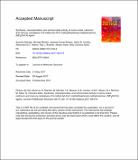Synthesis, characterization and antimicrobial activity of some nickel, cadmium and mercury complexes of 5-methyl-3yl-N-(2′-methylthiophenyl)-methyleneimine, (MPzOATA) ligand
Abstract
Abstract Herein, we report the syntheses and structures of Ni(II) complexes, [Ni(MPzOATA)2] (Cl) (PF6) ( I ), [Ni(MPzOATA)2](ClO4)2.CH3CN (II) & [Ni(MPzOATA)2](BF4)2.H2O ( III ); Cd(II) complex, [Cd(MPzOATA)Cl2]2 ( IV ) and a Hg(II) complex, [Hg(MPzOATA)Cl2] ( V ), of a pyrazole based ‘NNS’ donor ligand, 5-methylpyrazole-3yl-N-(2′-methylthiophenyl)methyleneimine, (MPzOATA). The complexes are characterized byelemental analyses,electronic, IR, 1H NMR (only for IV & V ) spectral parameters, conductivity and fluorescence measurements. X-ray crystallographic data of the complexes reveal that the Ni(II) complexes have NiN4S2 octahedral coordination, one of them is a mixed-anion complex having Cl− and PF6− as counter anions; the Cd(II) complex is a chloro bridged binuclear complex with octahedral coordinationenvironment aroundeach metal centre, while the Hg(II) complex is a square pyramidal one. Among the reported complex species, the Ni(II) complexes are non-fluorescent, while the Cd(II) and Hg(II) complexes can be used as potential photoactive materials as indicated from their characteristicemission properties. The reported complexes are screened for their antimicrobial activities against some Gram positive and Gram negative microbial strains, and they are found to be potential antimicrobial agents in broad spectrum against both Gram positive and Gram negative bacteria.
Citation
Mandal , S , Mondal , M , Biswas , J K , Cordes , D B , Slawin , A M Z , Butcher , R J , Saha , M & Chandra Saha , N 2018 , ' Synthesis, characterization and antimicrobial activity of some nickel, cadmium and mercury complexes of 5-methyl-3yl-N-(2′-methylthiophenyl)-methyleneimine, (MP z OATA) ligand ' , Journal of Molecular Structure , vol. 1152 , pp. 189-198 . https://doi.org/10.1016/j.molstruc.2017.09.015
Publication
Journal of Molecular Structure
Status
Peer reviewed
ISSN
0022-2860Type
Journal article
Description
S.M. is thankful to the U.G.C., Govt. of India for providing financial support in the form of fellowship (videUGC Award No.: File No. 17-81/2008 (SA-I) dated: 04.1.2011). The financial support received from the University of Kalyani in the form of Personal Research Grant is thankfully acknowledged.Collections
Items in the St Andrews Research Repository are protected by copyright, with all rights reserved, unless otherwise indicated.

